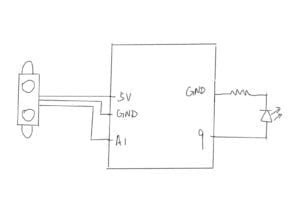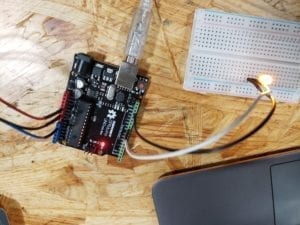
We picked an Infrared Distance Sensor for this recitation. This sensor uses laser to detect distance ranging from 4cm-30cm. We did not encounter many problems when completing the circuit – there is even no need for a breadboard. We just had to follow the instructions and diagrams. At first we did not use the map function and it worked well, as the following video shows.
Then we tried the map function. It also worked well – the LED dimmed as the distance became shorter – except for one problem – we forgot to add a resistor in the circuit and we didn’t realize it until a fellow pointed that out.

At the end, we added a resistor, though the dimming effect is not clear enough in this video.
Question 1:
What did you intend to assemble in the recitation exercise? If your sensor/actuator combination were to be used for pragmatic purposes, who would use it, why would they use it, and how could it be used?
We assembled an Infrared Distance Sensor (IDS) with Arduino. I suppose, for example, a cellphone user would use it. To put in other words, an IDS or some simillar distance sensor would be built into a cellphone. People use it in their cellphones to avoid unintended touches. Because when people make calls, they put their cellphone near their face and the face sometimes touches the phone screen. With a distance sensor, the phone will know it is the face touching the screen during a phone call, so it will choose not to respond to the touch.
Question 2:
Code is often compared to following a recipe or tutorial. Why do you think that is?
Code is basically instructions. You write down code to tell the computer what to do, and the computer executes the code line by line. Recipes and tutorials are also some kind of instructions, so it is fair to copare code with recipes or tutorials.
Question 3:
In Language of New Media, Manovich describes the influence of computers on new media. In what ways do you believe the computer influences our human behaviors?
Computers have made possible for human to focus on what really interests them within their limited time, instead of spending much time on repetitive and heavy and less meaningful work. For example, in old days, people have to check their article more than twice for typos and mistakes after completing it. Now we have auto correct and auto grammar checker, which make writing a lot easier. In general, computers have reduced human labor in every possible way. To put this in a more fundamental way, computers have replaced every human wherever computing is needed. They have freed human from doing calculations.